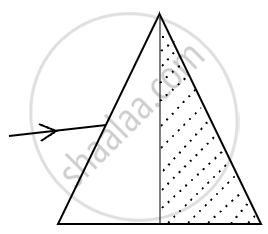Advertisements
Advertisements
Question
Answer the following question.
Calculate the angle of emergence (e) of the ray of light incident normally on the face AC of a glass prism ABC of refractive index `sqrt(3)`. How will the angle of emergence change qualitatively, if the ray of light emerges from the prism into a liquid of refractive index 1.3 instead of air?

Solution
Snell's law says `mu_1 Sin("i") = mu_2 Sin("r")`
`mu_"Prism" = sqrt(3)`
`mu_"Prism" = (30°) = sin (e)`
`sqrt(3) xx 1/2 = sin (e)`
`e = 60°`
Now when the external medium is changed to liquid of `mu_"L" = 1.3 "then",`
`mu_"prism" Sin (30) = mu_"L" sin (e)`
`sqrt(3) Sin (30°) = 1.3 Sin (e)`
`"e" = Sin^-1 (sqrt(3)/(2xx1.3)) = 41.83°`
Hence the angle of emergence reduces to 41.83° from 60°.
APPEARS IN
RELATED QUESTIONS
Find the angle of incidence at face AB so that the emergent ray grazes along the face AC.
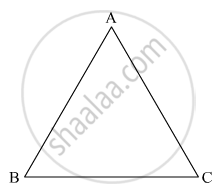
Write the relationship between angle of incidence ‘i’, angle of prism ‘A’ and angle of minimum deviations for a triangular prism.
A ray of light, incident on an equilateral prism `(μ_g = sqrt3)`moves parallel to the base line of the prism inside it. Find the angle of incidence for this ray.
Trace the path of the ray (P) of light passing through the glass prism as shown in the figure. The prism is made of glass with critical angle ic = 41°.
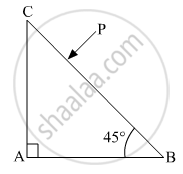
Three light rays red (R), green (G) and blue (B) are incident on a right angled prism ‘abc’ at face ‘ab’. The refractive indices of the material of the prism for red, green and blue wavelengths are 1.39, 1.44 and 1.47 respectively. Out of the three which colour ray will emerge out of face ‘ac’? Justify your answer. Trace the path of these rays after passing through face ‘ab’.
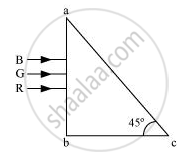
Suggest a method to produce a rainbow in your house.
A prism is made of glass of unknown refractive index. A parallel beam of light is incident on the face of the prism. The angle of minimum deviation is measured to be 40°. What is the refractive index of the material of the prism? The refracting angle of the prism is 60°. If the prism is placed in water (refractive index 1.33), predict the new angle of minimum deviation of a parallel beam of light.
An infinitely long cylinder of radius R is made of an unusual exotic material with refractive index –1 (Figure). The cylinder is placed between two planes whose normals are along the y direction. The center of the cylinder O lies along the y-axis. A narrow laser beam is directed along the y direction from the lower plate. The laser source is at a horizontal distance x from the diameter in the y direction. Find the range of x such that light emitted from the lower plane does not reach the upper plane.
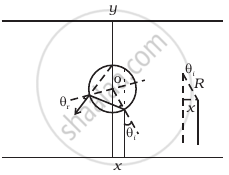
The maximum value of the index of refraction of a material of a prism which allows the passage of light through it when the refracting angle of the prism is A is ______.
A ray of light when incident upon a thin prism suffers a minimum deviation of 39°. If the shaded half portion of the prism is removed, then the same ray will ______.
